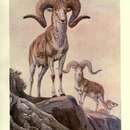Biology
provided by Arkive
Argalis are highly gregarious animals, found in large single-sex herds that may number up to 100 individuals (2). During the mating season, these herds come together and males will compete for access to the receptive females (2). These are often violent and the clashing of horns can be heard reverberating around the mountains (2). Around 5 months later, females give birth to a litter of 1 or 2 lambs; they separate from the main herd in order to give birth and the newborns remain hidden in the grass whilst their mother feeds (2).
These sheep graze on grasses, herbs and sedges; herds may migrate to higher elevations during the summer months in search of fresh pasture (2).
Conservation
provided by Arkive
It is possible that the sustainable management of hunting could offer some hope to the conservation of certain populations of argali (5). Although controversial, this practice increases the value of the species to local people, protects habitat and with careful monitoring the revenue obtained can be ploughed back into conservation (5). Two of the most at-risk subspecies, O. a. hodgsonii and O. a. nigrimontana, are listed on Appendix I of the Convention on International Trade in Endangered Species (CITES) (3).
Description
provided by Arkive
The argali is the largest of the wild sheep, and the males have impressive horns that are highly prized by hunters (2). Currently 9 different subspecies are recognised, which vary both in their appearance and in their range (1)(2). In general, argalis have a light brown coat with white legs and a white rump patch (4). Although both sexes have horns, those of the male are much larger and more impressive; they can be up to 13% of the males' body mass (4). The corkscrew horns wind forwards and are of a formidable weight; those of mature Altai argali (Ovis ammon ammon) males weigh 20 - 22 kg (4). Males also have a ruff of white hair around the neck and a pronounced crest along the back, which adds to their impressive appearance (2).
Habitat
provided by Arkive
Argalis are found in mountainous areas between 1,300 and 6,100 metres above sea level (2), where there are dry alpine habitats (4).
Range
provided by Arkive
Argalis are found throughout central Asia; the subspecies are confined to different areas, ranging from O. a. severtzovi in Uzbekistan to the west and the Altai argali (O. a. ammon) in Mongolia to the east (1).
Status
provided by Arkive
Classified as Vulnerable (VU - A2cde) on the IUCN Red List 2002 (1), and listed on Appendix II of CITES (3).
Subspecies: Altai argali (Ovis ammon ammon) classified as Vulnerable (VU - A2cde, C1); Kazakhstan argali (O. a. collium) classified as Vulnerable (VU - A2cde, C1); Gobi argali (O. a. darwini) Endangered (EN - C1); Tibetan argali (O. a. hodgsonii) Vulnerable (VU - A2cde); Northern Chinese argali (O. a. jubata) Critically Endangred (CR - C2a); Tien Shan argali (O. a. karelini) Vulnerable (VU - A2cde, C1+2a); Kara Tau argali (O. a. nigrimontana) Critically Endangered (CR - C2b); Marco Polo argali (O. a. polii) Vulnerable (VU - A2cde, C1); Kyzylkum sheep (O. a. severtzovi) Endangered (EN - A2cde, C2b) (1).
Threats
provided by Arkive
Argalis are threatened throughout their range but some subspecies are in a far worst situation than others. Habitat loss caused by the introduction of domestic sheep is perhaps the most pertinent threat to their survival (2). Hunters have traditionally valued the magnificent horns and hunting affects population numbers throughout their range (1).

